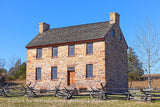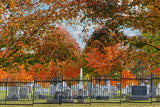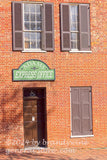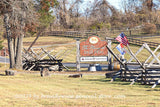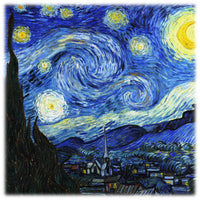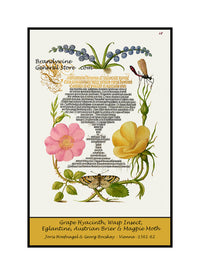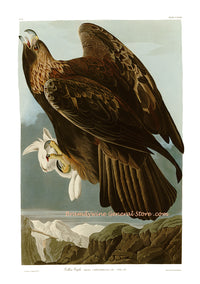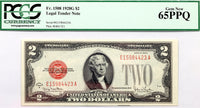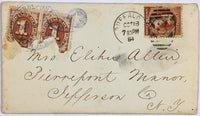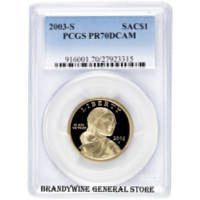Tyrant Fly Catcher by John James Audubon art print
An archival premium Quality art Print of the Tyrant Flycatcher by John James Audubon for sale by Brandywine General Store. This small songbird was plate or picture number 79 in Audubon's great ornithology book, The Birds of America, the first Havell edition. The painting shows a male and female specimen with the male having a bumble or honey bee in its mouth. The female is perched in a small branch above the male. The birds are in a cottonwood tree with that is in full bloom. The cottonwood tree was described as having its buds covered in a resinous substance that have an agreeable smellThe Tyrant Flycatcher, or, as it is commonly named, the Field Martin, or King-bird, is one of the most interesting visiters of the United States, where it is to be found during spring and summer, and where, were its good qualities appreciated as they deserve to be, it would remain unmolested. But man being generally disposed to consider in his subjects a single fault sufficient to obliterate the remembrance of a thousand good qualites, even when the latter are beneficial to his interest, and tend to promote his comfort, persecutes the King-bird without mercy, and extends his enmity to its whole progeny. This mortal hatred is occasioned by a propensity which the Tyrant Flycatcher now and then shews to eat a honey-bee, which the farmer looks upon as exclusively his own property. The Field Martin arrives in Louisiana, from the south, about the middle of March. Many individuals remain until the middle of September, but the greater number proceed gradually northwards, and are dispersed over every portion of the United States. For a few days after its arrival, it seems fatigued and doleful, and remains perfectly silent. But no sooner has it recovered its naturally lively spirits, than its sharp tremulous cry is heard over the fields, and along the skirts of all our woods. It seldom enters the forests, but is fond of orchards, large fields of clover, the neighbourhood of rivers, and the gardens close to the houses of the planters. In this last situation its habits are best observed. Its flight has now assumed a different manner. The love-season is at hand. The male and female are seen moving about through the air, with a continued quivering motion of their wings, at a height of twenty or thirty yards above the ground, uttering a continual, tremulous, loud shriek. The male follows in the wake of the female, and both seem panting for a suitable place in which to form their nest. Meanwhile, they watch the motions of different insects, deviate a little from the course of their playful rounds, and with a sweeping dart secure and swallow the prey in an instant. Probably the next sees them perched on the twig of a tree, close together, and answering the calls Of nature. The choice of a place being settled by the happy pair, they procure small dry twigs from the ground, and rising to a horizontal branch, arrange them as the foundation of their cherished home. Flakes of cotton, wool or tow, and other substances of a similar nature, are then placed in thick and regular layers, giving great bulk and consistence to the fabric, which is finally lined with fibrous roots and horse-hair. The female then deposits her eggs, which are from four to six in number, broadly ovate, reddish-white, or blush colour, irregularly spotted with brown. No sooner has incubation commenced, than the male, full of ardour, evinces the most daring courage, and gallantly drives off every intruder. Perched on a twig not far from his beloved mate, in order to protect and defend her, he seems to direct every thought and action to these objects. His snow-white breast expands with the warmest feelings; the feathers of his head are raised and spread, the bright orange spot laid open to the rays of the sun; he stands firm on his feet, and his vigilant eye glances over the wide field of vision around him. Should he espy a Crow, a Vulture, a Martin, or an Eagle, in the neighbourhood or at a distance, he spreads his wing to the air, and pressing towards the dangerous foe, approaches him, and commences his attack with fury. He mounts above the enemy, sounds the charge, and repeatedly plunging upon the very back of his more powerful antagonist, essays to secure a hold. In this manner, harassing his less active foe with continued blows of his bill, he follows him probably for a mile, when, satisfied that he has done his duty, he gives his wings their usual quivering motion, and returns exulting and elated to his nest, trilling his notes all the while. Few Hawks will venture to approach the farm-yard while the King-bird is near. Even the cat in a great measure remains at home; and, should she appear, the little warrior, fearless as the boldest Eagle, plunges towards her, with such rapid and violent motions, and so perplexes her with attempts to peck on all sides, that grimalkin, ashamed of herself, returns discomfited to the house. The many eggs of the poultry which he saves from the plundering Crow, the many chickens that are reared under his protection, safe from the clutches of the prowling Hawks, the vast number of insects which he devours, and which would otherwise torment the cattle and horses, are benefits conferred by him, more than sufficient to balance the few raspberries and figs which he eats, and calculated to insure for him the favour and protection of man...." Audubon Birds art print #79



